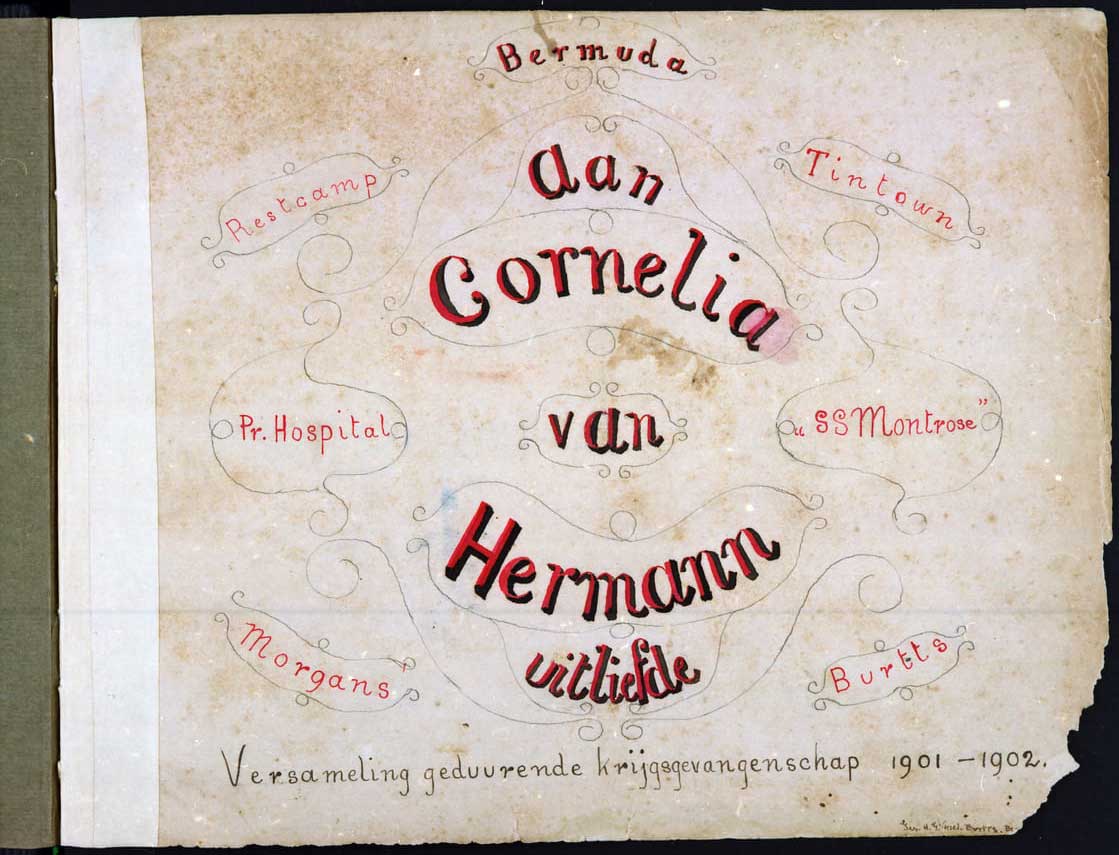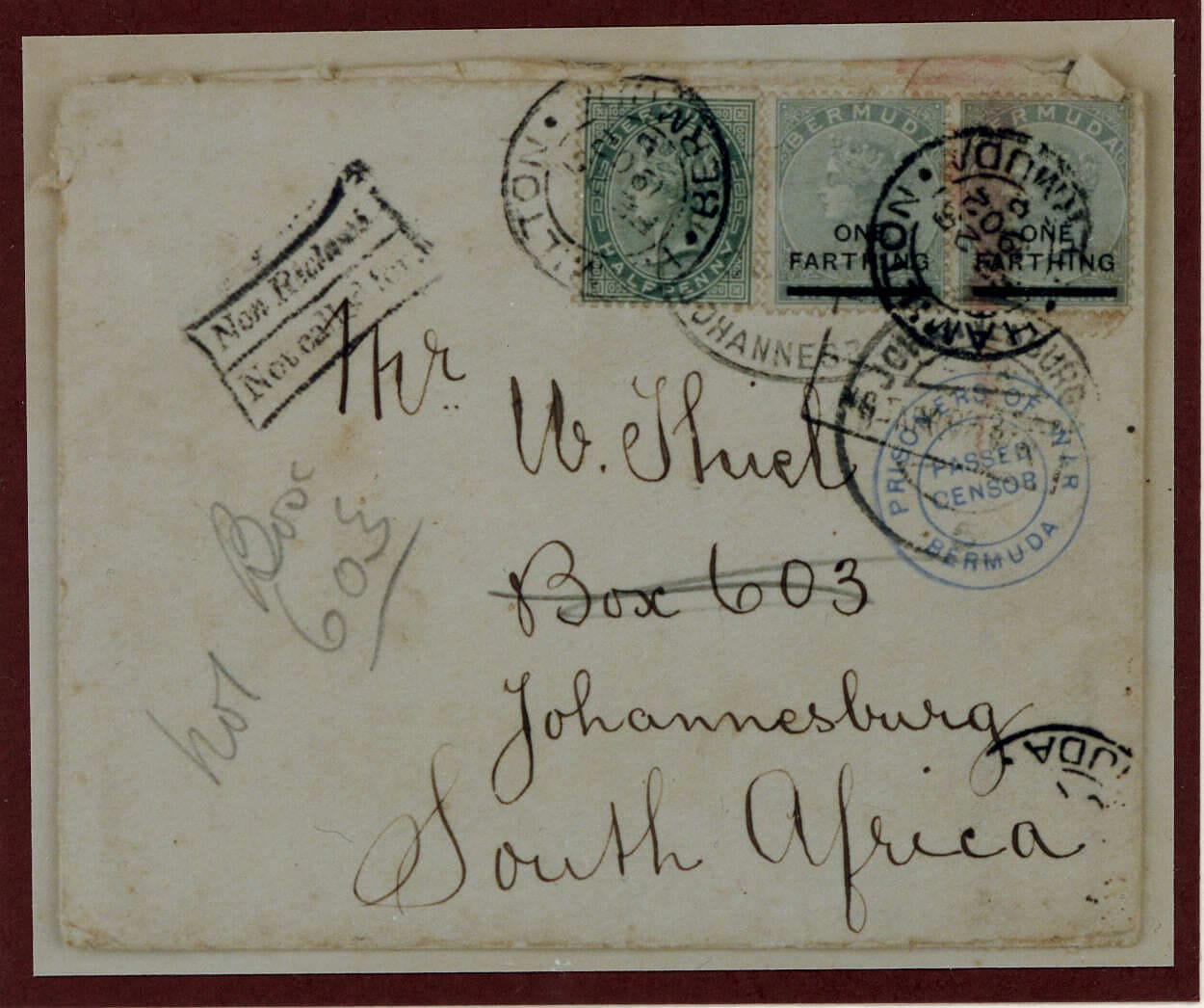In the diaries Hermann Thiel kept in Bermuda, he mentions how important letters from home were to all the prisoners. Delivery of mail was infrequent and often carried sad news about relatives who lost their lives in the war. Hermann wrote regularly in Dutch to his wife in Pretoria and her family in The Netherlands. He also corresponded in German with his family in the Transvaal and Germany. He saved several envelopes of letters from various locations and included them in his memorial album, which he dedicated to his wife, Cornelia, who was left behind in the Transvaal with their firstborn child, Martha Philomina Johanna Thiel.
The addresses, postage stamps, and censor marks on some of these envelopes are of interest to philatelists and historians interested in the Anglo-Boer War. Some of the envelopes are shown here with notes on what makes them interesting.
Letters re-directed from Tin Town Camp, Ladysmith, to Bermuda
After Hermann Thiel was captured in the Northern Transvaal he spent time in hospital in Pretoria, whereafter he was sent to Durban where the prisoners would board the ship for Bermuda. On their way to Durban, they had to wait a considerable time in Tin Town Camp in Ladysmith. However, some letters from family members to the Ladysmith camp arrived late and had to be forwarded. Hermann Thiel saved three envelopes and included them in his Memorial album.
Two letters addressed to H.G. Thiel as POW in Tin Town Camp, Ladysmith, and posted in Pretoria on 3 and 9 August 1901 were re-directed to Bermuda by crossing out “Tin Town Camp/Ladysmith” with blue pencil and applying the red handstamp “BERMUDA.”

Redirection of mail between POW camps on different Bermuda Islands
Incoming mail to the Boer Prisoners of War likely went first to Tuckers Island, where the prisoners most sympathetic to the British were held. From there, the letters were redirected to the other five islands in Bermuda’s Great Sound. The letters below show some of the redirection marks.
The letter, on the left, sent on 6 May 1902 from Burscheid in Germany via England to H.G Thiel on Morgans Island, Bermuda has the “Morgans” crossed out in red ink and contains the red handstamp “NOT TUCKERS”. It also shows “Not Hawkins” and “Burtts” written in both red ink and blue pencil as well as “Try Burtts” in red ink.
This letter, on the right, was sent on 4 April 1902 from Pretoria and addressed to H.G. Thiel on Morgans Island, Bermuda, with the “Morgans” crossed out in red ink and “Burtts” substituted in red ink.
Mail between two overseas POW camps
Many Boer prisoners of war had relatives in other overseas camps with whom they corresponded. The letter below was sent on 12 February 1902 from the Deadwood Camp in St. Helena to H.J. Willemse in the camp on Morgans Island, Bermuda, by a relative of the same name. The envelope of the letter was most probably given to Hermann Thiel to include it in his Memorial Album.
The letter has the censor mark consisting of a double triangle struck in violet, reading “PASSED BY/CENSOR/DEADWOOD.” It also has initials in black ink in the center, as seen on other covers between 8 October 1901 and 12 February 1902.

Letters to a Prisoner of War on St. David Island, Bermuda
In all the records on the Boer Prisoners of War in Bermuda, no reference has ever been made to prisoners being held on St. David Island. Hermann Thiel, however, received two letters addressed to St. David Island, Bermuda. He included both envelopes in his Memorial Album.
The first letter was sent in November 1901 from Pretoria and had the typical censor mark: a double triangle struck in black, reading “PASSED/PRESS/CENSOR” with “PRETORIA” in the center of the triangle.
The second letter, from the Cape of Good Hope, was stamped in Hamilton, Bermuda, on 1 February 1902. It contains the most common censor mark used in Bermuda: a double circle with “PRISONERS OF WAR/BERMUDA” between the circles and “PASSED/CENSOR” in the centre. The letter most probably came from his brother Otto Theodore Thiel in Cape Town.
All three letters addressed to Hermann Thiel on St David’s Island arrived within three months after the prisoner arrived in Bermuda on 13 September 1901. He does not mention in his diaries that he ever spent time on St David’s Island, nor is there any information on the detention of POWs on St David’s Island. One can only speculate that the senders assumed that the letters would reach him if they addressed it in that way.

H.G. Thiel saved two letters, which were posted in Hamilton, Bermuda.
One of the letters was addressed to him as a POW on Morgans Island and stamped in the Hamilton Post Office on 16 November 1901. It contains the censor mark struck in blue, consisting of a double circle with “PRISONERS OF WAR/BERMUDA” between the circles and “PASSED/CENSOR” in the center.
H.G. Thiel sent the second letter to a relative in Johannesburg. It was stamped in Hamilton, Bermuda, on 25 February 1902. It has the same Bermuda censor mark as the other letter and arrived in Johannesburg, as indicated by two “JOHANNESBURG” markings. The letter was never collected as it was stamped “Not called for” and “Not Box 603” was written in pencil. It is unknown how it was returned to H.G. Thiel for him to include it in his commemorative album.
Censor marks used in Bermuda
Four hand stamped censor marks have been recorded on letters of Prisoners of War in Bermuda. Examples of two of these marks appear on the letters below.
The letter posted in Burscheid in Germany, and the letter posted on 18 February 1902 in Oudewater, The Netherlands, have the most common censor mark stamped in violet and blue, respectively. The censor mark consists of a double circle with “PRISONERS OF WAR/BERMUDA” between the circles and “PASSED/CENSOR” in the centre.
Censor Marks using the abbreviation “PBC” for “Passed by censor”
Most of the letters from home received by prisoners of war in Bermuda were censored where they were posted. Two unusual censor marks are shown below.
The letter posted to Hermann Thiel from Germiston on 13 March 1902 contains the censor mark struck in purple, consisting of a double, equilateral triangle with the point down. It has “PBC” (the abbreviation for “Passed by Censor”) between the triangles and the name of the town “ELANDSFONTEIN” and an asterisk (*) in the centre of the triangle. The name of the town “Elandsfontein” was changed to “Germiston” around the time this letter was posted, and this is reflected in the censor stamp and post office stamp.


















